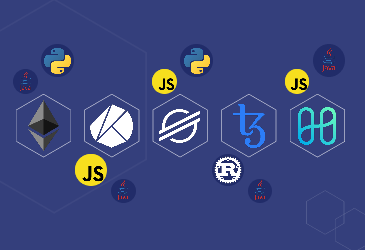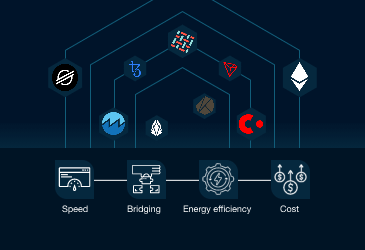
Stellar: The next-generation payment technology
While most third-generation platforms focus on dApp development, Stellar blockchain emerges as a powerful blockchain ecosystem that supports digital representations of various forms of money. It is an open-source network primarily built for currencies and payments.
The initial idea of Stellar blockchain was to help enterprises, and single-dev startups optimize their existing financial system and seamlessly move money across diverse markets. However, at its core, Stellar is a blockchain-powered decentralized protocol ideal for supporting dApps like decentralized exchanges and trading dApps. For development, Stellar blockchain offers a range of developer tools, technical docs, APIs, and more. It facilitates anyone to build applications and services aimed at cross-border transactions and micropayments.
About Stellar
Stellar is an open-source blockchain ecosystem designed to support digital assets and payments. Stellar’s native currency is Lumen or XLM, which pays the network’s computation fees and incentivizes validators. Leveraging Stellar’s powerful public ecosystem, enterprises can create, mint, and trade tokenized versions of real-world money, providing a common unified infrastructure where the global financial system can operate.
Being a decentralized ecosystem, Stellar blockchain also enables developers to build customized dApps for various purposes. Stellar offers the following built-in integrations to help enterprises transform their legacy operations related to money and finance:
- Customized payment apps- Leverage a fully functional Stellar global payment app that can handle multiple currencies on the Stellar network.
- Decentralized asset exchanges- Use Stellar’s official DEX for trading and managing cryptos, securities and forex with innovative technologies such as asset swapping.
- Micropayment services- Utilize Stellar’s micropayment services which are cost-efficient and fast.
Consensus mechanism
Stellar blockchain adopts a unique algorithm named SCP, Stellar consensus protocol. This consensus is based on the Federated Byzantine Agreement (FBA) model, which is open for membership. Nodes on the Stellar network first learn the local configuration of entire quorum members and then recognize their node-specific quorums. With this approach, SCP addresses the limitations of proof-of-work and proof-of-stake consensus algorithms while being easily configurable, highly scalable and energy-efficient.
Stellar’s Architecture
Stellar introduces an open-source ledger ecosystem that primarily functions as a reliable ownership tracking system. However, Stellar has a vast network of computers to check and recheck each other’s work. Blocks are added to the chain once everyone verifies and agrees on the authenticity of a transaction.
While networks and nodes are the core layers of Stellar blockchain, it offers a powerful API on top of this layer. Because they use this API, developers do not require an understanding of the complexities of distributed consensus. Instead, they can connect to Stellar’s API and start building assets, making markets and issuing assets on the Stellar ecosystem.
How does Stellar payment work?
The current traditional banking ecosystem is fragmented. Each region and each country has its payment methods and are not interoperable. Although cross-geographical transaction services like Western Union or SWIFT exist, it takes around five minutes to one hour and sometimes days to transfer money. Moreover, the fee for each transaction can be quite expensive for an average person.
Stellar blockchain tries to bridge these disparate local payment systems using anchors. Stellar payment and its working function cannot be described without touching upon Anchors. Anchors are like bridges. They link the Stellar network to traditional banking rails or different currencies around the world and make the currencies interoperable on a single platform. So, what exactly are anchors and how does it help in Stellar cross-border payments?
Anchors are trusted entities and can be regulated by financial institutions like banks, money service businesses or fintech companies offering specific services to the network. They serve two main functions on the network, which are:
- Issue 1:1 fiat-backed tokens
- Offer fiat on/off ramps.
As issuers of fiat tokens, anchors issue 1:1 fiat tokens, also known as stablecoins and preserve fiat reserves corresponding to the value of the issued token. This helps users to redeem them back to fiat at any time. However, a way to get those tokens to the blockchain should also exist, and this is where the anchor’s second function comes into play.
As fiat on/off ramp providers, anchors link the Stellar network to the anchor’s country banking system via services that handle regulatory processes such as KYC/AML. It enables users to make seamless deposits and withdrawals. Anchors on a Stellar network can serve one or both functions.
Stellar Payment – Example
Stellar’s interoperability allows assets to move seamlessly within and off the Stellar network. This makes real-world assets useful in the digital world and vice versa. Let us see how Stellar payment works in practical application.
Say Casey lives in the USA and wants to send some money to his cousin Lara, who resides in Australia. The amount of money that Casey wants to send is 3000 USD, which converts to Australian Dollars or AUD.
Say, Casey has an account in Bank X based in the USA, and Lara has an account in Bank Y in Australia. Assume that these banks are “Anchors” connected to the Stellar network.
So, how does this cross-border transaction occur via the Stellar network?
When Casey sends Lara 3000 USD, a transaction intent is dispatched to Bank Y within seconds to check if Lara agrees to it. Once Bank X receives Bank Y’s approval, the required fund gets deducted from Casey’s account.
The deducted USD gets transferred to the pool account of Bank X and gets issued into the equivalent XLM tokens in the Stellar network. It now will look for the best exchange rate to convert the XLM into AUD. This money is then transferred to the base account of Bank Y, which is then credited to Lara’s account.
Benefits of using Stellar
- Speed – Each Stellar transaction needs only about three to five seconds of confirmation time.
- Low transaction fees – The average transaction fee of Stellar is $0.00001 XLM per transaction.
- Security – Every transaction detail and data of the Stellar network is stored in a decentralized, public ledger, making it very secure and near impossible to tamper with.
- Minimum balance – Anyone opening a new account in Stellar must hold 2 XLMs to activate and perform activities. This lessens the possibility of fake account creation.
Key features
As an open, interoperable ecosystem, Stellar blockchain offers a range of power-packed features to simplify the creation and management of fintech products.
Digital asset creation
Stellar allows enterprises to quickly create and issue redeemable and tradable representations of any asset via tokenization. Users can trade these tokenized assets across various decentralized exchanges and marketplaces.
Peer-to-peer tokens trading
With peer-to-peer trading and ecosystem interoperability, Stellar supports the exchange of Stellar’s token with any token on the network. Besides, it seamlessly connects buyers and sellers in a non-custodial approach for better trades.
Quick token swapping
Stellar blockchain allows users to transform their currencies while sending them. It enables users to send a particular currency and helps recipients receive the transformed version of that currency, eliminating barriers to convenient token exchange.
Founders
Jed McCaleb, the founder of Mt. Gox and co-founder of Ripple, launched the Stellar project in 2014 with the vision to transform traditional money and fintech technologies.
Ripple vs. Stellar
Although Stellar may seem similar to Ripple, both are, at their core, different. Ripple, launched in 2012, is a permissioned and centralized digital payment network. It is a profit-making organization that facilitates payment for large corporations and financial institutions and is prone to censorship owing to its centralized nature. Some of the partners of Ripple include Kotak and Axis Bank.
Stellar fundamentally envisions reaching the unbanked and offering them the financial services they require. It is a permissionless or open, decentralized blockchain platform launched in 2014. Moreover, it is a non-profit organization and offers low-cost P2P transactions. It is free from censorship, and some of its partners are Smartlands, AnchorUSD and Wirex.
Popular Use cases
Fintech dApps
Stellar’s ecosystem has multiple use cases, from supporting the creation of digital currencies to helping enterprises tokenize their assets. However, developers can utilize the open-source ecosystem of Stellar to build innovative and customized dApps. These dApps can further integrate Stellar-based tokens for transparent and streamlined trading and exchange operations.
Stellar cross-border payments
Cross-border solutions built on Stellar aim to replace the tiresome traditional currency conversion and international wire approach with a faster and more efficient approach to sending/receiving payments overseas. It employs a unique system in which two anchors- Anchor 1 and Anchor 2, bridge the gap between the service provider and receiver in a truly decentralized manner.
Exchanges
Stellar blockchain offers a unified infrastructure to traditional and digital finance enterprises, granting them access to a wide range of Stellar-backed assets and local currencies. Institutions can leverage Stellar to issue assets and regulate payments within an interoperable ecosystem of diverse projects and native currencies.
Beyond financial markets, Stellar blockchain can be leveraged to build services and solutions to ensure organizations and firms securely perform crucial functions. Stellar’s unique features and benefits can be handy in developing purpose-built applications. Some of the application ideas include the following:
- P2P lending
- Mobile and trading clients
- Merchant plugin
- Anchors in more currencies
- API mashups
- Microinsurance
- Loyalty points programs
- Conditional cash transfers
- Donation systems for non-profits
- Time banks
- Anywhere ATM or human ATM mobile apps
- Volunteer hour tracking
- Micro savings account for school, insurance, health etc.,
Roadmap
Based on their publicly available 2022 roadmap, the Stellar community is dedicated to performing research to improving smart contracts’ existing capabilities, and launching new products, thereby strengthening the Stellar ecosystem to scale higher growth.
Stellar blockchain aims to act as a building block to interoperability between modern and traditional financial systems and include every diverse community in the network, reaching even the unbanked. The 2022 roadmap of Stellar blockchain is designed around the following three strategic building blocks:
- To increase network scalability and network innovation by extending network capacity.
- Enabling higher network participation via ecosystem input and engagement. The network envisions driving greater commitment and ownership within the ecosystem through marketing, partnerships, community activities and more.
- Do the required research to understand the foothold of the ecosystem and how far it has reached in achieving its mission of promoting diversity and inclusion.
If you want to know the performance of the Stellar network, its ecosystem score and ranking, the foundation tools it provides, and more, you can check out the Stellar review and rating on Scortik.
Insights

What are SDKs? Top blockchains and their SDKs
A software development kit or SDK is a set of tools and programs utilized to build and integrate customized applications for any existing or new platform.

How to Choose a Blockchain Protocol Suitable to Your Project?
Need help choosing the right blockchain protocol for your project? Use Scortik to evaluate protocols’ overall performance and make the right choice.

WanChain: Empowering Blockchains With Interoperability
Wanchain is a blockchain interoperability and decentralized finance platform that connects multiple blockchains with one another.